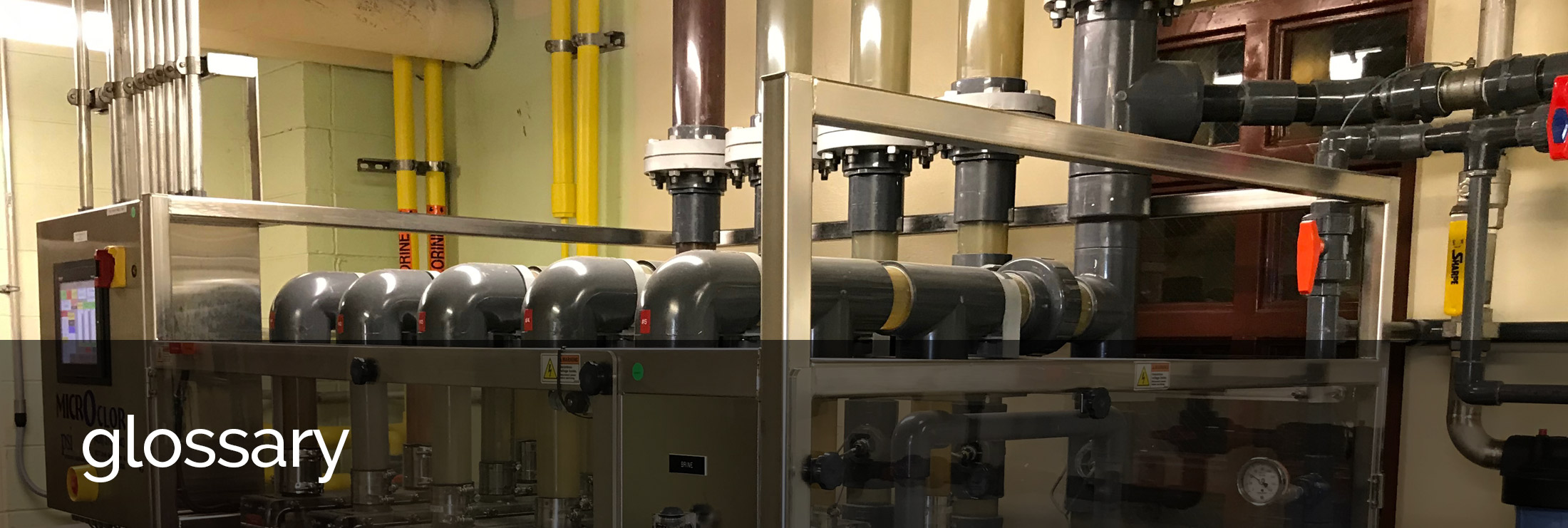
Ever wonder what Cryptosporidium is? Here are some terms related to wastewater treatment, along with their meaning. Click on any term below to learn more about it.
Actinomycetes
A group of anaerobic and aerobic bacteria that can be present in soil, lake and river muds. Actinomycetes produce geosmin, 2-methylisoborneol, or both, compounds that produce earthy/musty odors at very low levels.
Activated Carbon
A form of particulate carbon with increased surface area to enhance adsorption of soluble contaminants. The primary source of activated carbon is bituminous coal, which is activated through a combustion process.
Alum
Al2(SO4)3 – The common name for aluminum sulfate, a chemical used in the coagulation process to remove particles from water.
Benthic
Relating to the bottom or bottom environment of a body of water.
Chlorine
A chemical which destroys pathogens in water.
Coagulation
The process of destabilizing charges on particles in water by adding chemical (coagulants).
Coliform
A group of bacteria commonly found in the environment. They are an indicator of potential contamination of water. Adequate and appropriate disinfection effectively destroys coliform bacteria.
Contaminant
Any natural or man-made physical, chemical, biological, or radiological substance or matter in water, which is at a level that may have an adverse effect on public health, and which is known or anticipated to occur in public water systems.
Cryptosporidium
A disease-causing parasite, resistant to chlorine disinfection. It may be found in fecal matter or contaminated drinking water.
E. coli
Escherichia coli is a bacterium commonly found in the human intestine. For water quality analyses purposes, it is considered an indicator organism. These are considered evidence of water contamination. Indicator organisms may be accompanied by pathogens, but do not necessarily cause disease themselves.
Enterovirus
A virus whose presence may indicate contaminated water; a virus which may infect the gastrointestinal tract of humans.
Fecal Coliform
A group of bacteria that may indicate the presence of human or animal fecal matter in water.
Filtration
A series of process that physically removes particles from water.
Finished Water
Treated drinking water that meets state and federal drinking water regulations.
Flocculation
The water treatment process following coagulation that uses gentle stirring to bring suspended particles together so they will form larger, more settleable clumps called flocs.
Geosmin
An earthy-smelling chemical produced by certain blue-green algae and actinomycetes.
Giardia Lamblia
A pathogenic parasite which may be found in contaminated water.
Hydrogen Peroxide
Strong oxidizing agent. Ozone (O3) used in combination with hydrogen peroxide is used in some advanced oxidation process to produce hydroxyl radicals (•OH).
Leaching
A chemical reaction between water and metals that allows for removal of soluble materials.
Maximum Contaminant Levels (MCLs)
The maximum allowable level of a contaminant that federal or state regulations allow in a public water system. If the MCL is exceeded, the water system must treat the water so that it meets the MCL.
Maximum Contaminant Goal (MCLG)
The level of a contaminant in drinking water below which there is no known or expected risk to health. MCLGs allow for a margin of safety.
2-methylisoborneol (2-MIB)
A musty-camphor smelling chemical produced by certain blue-green algae and actinomycetes.
Microbe, Microbial
Any minute, simple, single-celled form of life, especially one that causes disease.
Mg/L
Milligrams per liter
mL
Milliliter
NTU (Nephelometric Turbidity Unit)
A measure of the clarity of water.
Ozonation
The process of applying ozone (O3) to water for disinfection and oxidation for taste and odor control. Ozone must be produced on site by applying an electrical current to oxygen.
Pathogens
Also: Disease-causing Pathogens or Waterborne Pathogens – A pathogen is a bacterium, virus or parasite that causes or is capable of causing disease. Pathogens may contaminate water and cause waterborne disease.
pCi/L, Picocuries per Liter
A curie is the amount of radiation released by a set amount of a certain compound. A picocurie is one quadrillionth of a curie.
pH
A measure of the acidity or alkalinity of water.
Planktonic
Small, usually microscopic plants (phytoplankton) and animals (zooplankton) passively floating in a body of water. They are used as food by higher aquatic life forms such as fish.
Potable Water
Water that is safe to drink.
Powdered Activated Carbon (PAC)
Activated carbon composed of fine particles and providing a large surface area for adsorption used to remove taste and odor causing compounds or trace organic contaminants.
Raw Water
Water that has not been treated in anyway; it is generally considered to be unsafe to drink.
Solder
A fusible alloy used to join metallic parts.
Standpipe
A water tank that is taller than it is wide.
Surface Water
Water which is open to the atmosphere and subject to surface runoff; generally, lakes, streams, rivers.
Treated Water
Disinfected and/or filtered water served to water system customers. It must meet or surpass all drinking water standards to be considered safe to drink.
Trihalomethanes (THM)
Four separate compounds including chloroform, dichlorobromomethane, dibromochloromethane, and bromoform.
Turbidity
A measure of the cloudiness of water caused by suspended particles.
Valve
A device that opens and closes to regulate the flow of liquids. Faucets include valves.
Water Works
All of the pipes, pumps, reservoirs, dams, and buildings that make up a water system.
Zebra Mussel
A bivalve mussel that has become a serious pest, because it blocks intake pipes.
